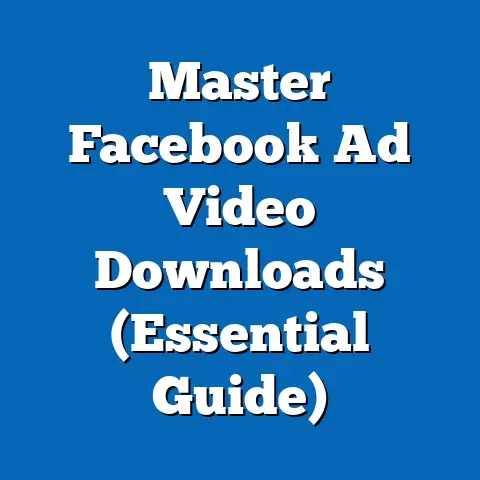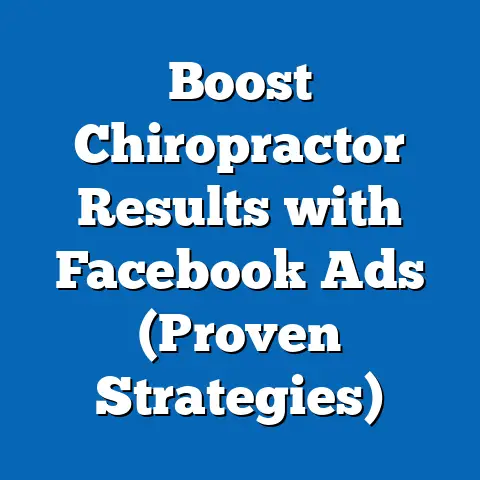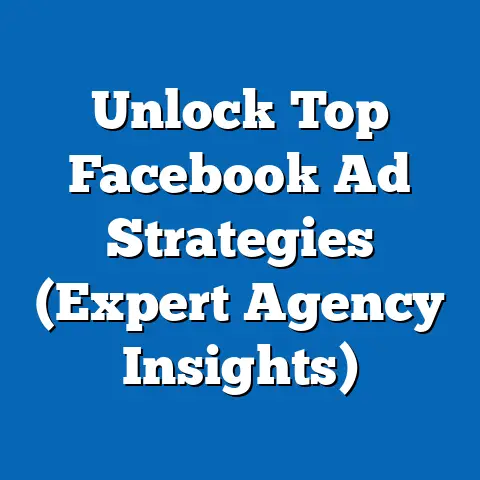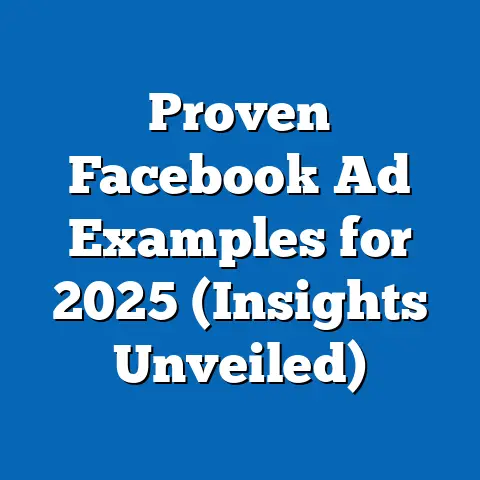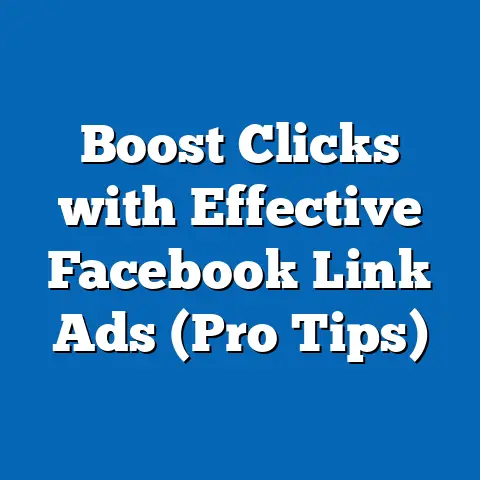Launch a High-Impact Conversion fb ad (Proven Strategies)
I’ve seen it time and time again: businesses launching Facebook ads with beautiful imagery and clever slogans, only to be met with disappointing results. They pour money into their campaigns, hoping for a flood of conversions, but instead, they get a trickle. The biggest mistake I see isn’t a lack of creativity, it’s a lack of understanding. They’re focusing on what they think looks good, rather than what their audience responds to. It’s like throwing darts in the dark – you might hit something, but it’s unlikely to be the bullseye.
A high-impact conversion Facebook ad isn’t about flashy visuals; it’s about understanding your audience, crafting a message that speaks directly to their needs, and using Facebook’s powerful tools to connect with them effectively. It’s about strategy, data, and a little bit of art. In this guide, I’ll walk you through the proven strategies I use to launch conversion-focused Facebook ads that deliver real results. Forget guesswork; let’s build a campaign that actually works!
Understanding Your Audience
Before you even think about images or ad copy, you need to know your audience. I can’t stress this enough. Launching an ad campaign without understanding your target demographic is like trying to navigate a foreign city without a map. You might stumble upon something interesting, but you’re more likely to get lost and frustrated.
Audience research and segmentation are the cornerstones of successful Facebook advertising. Knowing your audience’s demographics (age, gender, location), interests (hobbies, passions, preferred brands), and online behaviors (what they click on, what they share) allows you to tailor your ads to resonate with them on a deeper level.
So, how do you get this crucial information? Here are a few tools and methods I rely on:
-
Facebook Audience Insights: This free tool within Facebook Ads Manager is a goldmine of information. It allows you to explore the demographics, interests, and behaviors of people on Facebook, both those connected to your page and those who aren’t. I use it to identify potential target audiences based on their interests, purchase behaviors, and even the pages they like.
-
Competitor Analysis: What are your competitors doing? Who are they targeting? Look at their Facebook pages, their ads (you can often see examples in their ad library), and the comments they receive. This can give you valuable insights into what’s working in your niche and help you identify underserved segments.
-
Customer Surveys and Interviews: Don’t underestimate the power of talking directly to your customers! Send out surveys, conduct interviews, and ask for feedback. This qualitative data can provide invaluable insights into their motivations, pain points, and desires.
-
Your Website Analytics: Tools like Google Analytics can provide data on your website visitors, including their demographics, interests, and how they interact with your content. This can help you identify which segments are most likely to convert.
Facebook Audience Insights: This free tool within Facebook Ads Manager is a goldmine of information. It allows you to explore the demographics, interests, and behaviors of people on Facebook, both those connected to your page and those who aren’t. I use it to identify potential target audiences based on their interests, purchase behaviors, and even the pages they like.
Competitor Analysis: What are your competitors doing? Who are they targeting? Look at their Facebook pages, their ads (you can often see examples in their ad library), and the comments they receive. This can give you valuable insights into what’s working in your niche and help you identify underserved segments.
Customer Surveys and Interviews: Don’t underestimate the power of talking directly to your customers! Send out surveys, conduct interviews, and ask for feedback. This qualitative data can provide invaluable insights into their motivations, pain points, and desires.
Your Website Analytics: Tools like Google Analytics can provide data on your website visitors, including their demographics, interests, and how they interact with your content. This can help you identify which segments are most likely to convert.
Once you’ve gathered this information, it’s time to create customer personas. A customer persona is a semi-fictional representation of your ideal customer. It’s more than just demographics; it includes their motivations, goals, challenges, and even their favorite brands.
For example, let’s say you’re selling organic skincare products. Your customer persona might look something like this:
Name: Sarah Miller
Age: 35
Occupation: Yoga Instructor
Location: San Francisco, CA
Interests: Yoga, healthy eating, natural living, environmental sustainability, conscious consumerism
Goals: To maintain healthy, glowing skin using natural and sustainable products.
Challenges: Finding skincare products that are both effective and aligned with her values. She’s skeptical of marketing claims and prefers products with transparent ingredients and ethical sourcing.
By creating detailed customer personas like this, you can start to understand your audience on a deeper level. This understanding will guide your ad creation process, ensuring that your message resonates with the right people.
Takeaway: Before launching any Facebook ad campaign, invest time in understanding your audience. Use Facebook Audience Insights, competitor analysis, customer surveys, and website analytics to gather data. Create detailed customer personas to guide your ad creation process and ensure your message resonates with the right people.
Crafting a Compelling Message
Now that you know who you’re talking to, it’s time to craft a message that speaks directly to their needs and desires. I often see businesses making the mistake of focusing on features rather than benefits. They talk about what their product is, instead of what it does for the customer.
Remember Sarah Miller, our yoga instructor persona? She’s not interested in a list of ingredients; she’s interested in healthy, glowing skin using natural and sustainable products. So, your ad copy should focus on those benefits.
Here are some proven strategies for writing attention-grabbing headlines and persuasive calls to action:
-
Focus on Benefits, Not Features: As I mentioned before, always highlight the benefits of your product or service. How will it improve your customer’s life? What problems will it solve? Instead of saying “Our skincare cream contains Vitamin C,” say “Get radiant, healthy skin with our Vitamin C-rich cream.”
-
Use Strong Action Verbs: Start your headline with a strong action verb that compels the reader to take action. Examples include “Discover,” “Unlock,” “Transform,” “Boost,” and “Get.”
-
Create a Sense of Urgency: Use language that creates a sense of urgency and encourages immediate action. Examples include “Limited Time Offer,” “Sale Ends Soon,” and “Don’t Miss Out.”
-
Address Pain Points: Identify the pain points of your target audience and address them directly in your ad copy. This shows that you understand their needs and have a solution to offer.
-
Use Social Proof: Include testimonials, reviews, or case studies to build trust and credibility. Seeing that other people have had positive experiences with your product or service can be a powerful motivator.
-
Keep it Concise: Facebook ad copy should be concise and to the point. Get your message across quickly and effectively.
-
A/B Test Your Ad Copy: Don’t be afraid to experiment with different headlines, body copy, and calls to action. A/B testing allows you to see what resonates best with your audience and optimize your ads for maximum conversion.
Focus on Benefits, Not Features: As I mentioned before, always highlight the benefits of your product or service. How will it improve your customer’s life? What problems will it solve? Instead of saying “Our skincare cream contains Vitamin C,” say “Get radiant, healthy skin with our Vitamin C-rich cream.”
Use Strong Action Verbs: Start your headline with a strong action verb that compels the reader to take action. Examples include “Discover,” “Unlock,” “Transform,” “Boost,” and “Get.”
Create a Sense of Urgency: Use language that creates a sense of urgency and encourages immediate action. Examples include “Limited Time Offer,” “Sale Ends Soon,” and “Don’t Miss Out.”
Address Pain Points: Identify the pain points of your target audience and address them directly in your ad copy. This shows that you understand their needs and have a solution to offer.
Use Social Proof: Include testimonials, reviews, or case studies to build trust and credibility. Seeing that other people have had positive experiences with your product or service can be a powerful motivator.
Keep it Concise: Facebook ad copy should be concise and to the point. Get your message across quickly and effectively.
A/B Test Your Ad Copy: Don’t be afraid to experiment with different headlines, body copy, and calls to action. A/B testing allows you to see what resonates best with your audience and optimize your ads for maximum conversion.
Examples of Effective Ad Copy:
Let’s look at a few examples of effective ad copy that led to high conversion rates:
-
Example 1: E-commerce (Clothing)
- Headline: “Upgrade Your Wardrobe: 30% Off All New Arrivals!”
- Body Copy: “Treat yourself to the latest styles at unbeatable prices. Our new arrivals are flying off the shelves, so don’t miss out! Shop now and get 30% off your entire order.”
-
Call to Action: “Shop Now”
-
Why it works: This ad copy focuses on the benefits of upgrading your wardrobe and offers a compelling discount to incentivize purchase. The sense of urgency (“flying off the shelves”) encourages immediate action.
-
Example 2: SaaS (Software as a Service)
- Headline: “Stop Wasting Time on Tedious Tasks: Automate Your Workflow with [Software Name]”
- Body Copy: “Tired of spending hours on repetitive tasks? [Software Name] automates your workflow, so you can focus on what matters most. Try it free for 14 days!”
-
Call to Action: “Start Free Trial”
-
Why it works: This ad copy directly addresses the pain point of tedious tasks and offers a solution in the form of automated workflow. The free trial provides a low-risk way for users to experience the benefits of the software.
-
Example 3: Local Business (Restaurant)
- Headline: “Craving Authentic Italian? Get 20% Off Your First Order at [Restaurant Name]!”
- Body Copy: “Indulge in delicious, authentic Italian cuisine made with fresh, locally sourced ingredients. Order online now and get 20% off your first order! See what everyone’s raving about!”
-
Call to Action: “Order Now”
-
Why it works: This ad copy appeals to the craving for authentic Italian food and offers a discount to incentivize first-time orders. The social proof (“See what everyone’s raving about!”) builds trust and credibility.
Example 1: E-commerce (Clothing)
- Headline: “Upgrade Your Wardrobe: 30% Off All New Arrivals!”
- Body Copy: “Treat yourself to the latest styles at unbeatable prices. Our new arrivals are flying off the shelves, so don’t miss out! Shop now and get 30% off your entire order.”
-
Call to Action: “Shop Now”
-
Why it works: This ad copy focuses on the benefits of upgrading your wardrobe and offers a compelling discount to incentivize purchase. The sense of urgency (“flying off the shelves”) encourages immediate action.
Call to Action: “Shop Now”
Why it works: This ad copy focuses on the benefits of upgrading your wardrobe and offers a compelling discount to incentivize purchase. The sense of urgency (“flying off the shelves”) encourages immediate action.
Example 2: SaaS (Software as a Service)
- Headline: “Stop Wasting Time on Tedious Tasks: Automate Your Workflow with [Software Name]”
- Body Copy: “Tired of spending hours on repetitive tasks? [Software Name] automates your workflow, so you can focus on what matters most. Try it free for 14 days!”
-
Call to Action: “Start Free Trial”
-
Why it works: This ad copy directly addresses the pain point of tedious tasks and offers a solution in the form of automated workflow. The free trial provides a low-risk way for users to experience the benefits of the software.
Call to Action: “Start Free Trial”
Why it works: This ad copy directly addresses the pain point of tedious tasks and offers a solution in the form of automated workflow. The free trial provides a low-risk way for users to experience the benefits of the software.
Example 3: Local Business (Restaurant)
- Headline: “Craving Authentic Italian? Get 20% Off Your First Order at [Restaurant Name]!”
- Body Copy: “Indulge in delicious, authentic Italian cuisine made with fresh, locally sourced ingredients. Order online now and get 20% off your first order! See what everyone’s raving about!”
-
Call to Action: “Order Now”
-
Why it works: This ad copy appeals to the craving for authentic Italian food and offers a discount to incentivize first-time orders. The social proof (“See what everyone’s raving about!”) builds trust and credibility.
Call to Action: “Order Now”
Why it works: This ad copy appeals to the craving for authentic Italian food and offers a discount to incentivize first-time orders. The social proof (“See what everyone’s raving about!”) builds trust and credibility.
Takeaway: Crafting a compelling message is crucial for driving conversions. Focus on benefits, not features, use strong action verbs, create a sense of urgency, address pain points, use social proof, keep it concise, and A/B test your ad copy.
Visual Elements that Convert
While compelling copy is essential, the visual elements of your Facebook ad play a critical role in capturing attention and driving engagement. I’ve seen countless ads with great copy that fall flat because the visuals are either uninspired or irrelevant. Your visuals should not only grab attention but also align with your messaging and audience preferences.
Here are some best practices for selecting images or creating video content that captures attention and drives engagement:
-
Use High-Quality Images: This seems obvious, but you’d be surprised how many ads use blurry or pixelated images. Make sure your images are high-resolution and visually appealing.
-
Showcase Your Product in Action: Instead of simply showing a picture of your product, show it being used. This helps potential customers visualize themselves using your product and experiencing its benefits.
-
Use Emotionally Evocative Images: Images that evoke emotions like happiness, excitement, or nostalgia can be highly effective in capturing attention and driving engagement.
-
Use Video to Tell a Story: Video is a powerful tool for telling a story and connecting with your audience on a deeper level. Create videos that showcase your product, share customer testimonials, or provide valuable information.
-
Keep Videos Short and Engaging: Attention spans are short, so keep your videos concise and engaging. Aim for videos that are 15-30 seconds long.
-
Use Text Overlays in Videos: Add text overlays to your videos to highlight key messages and make them easier to understand, even when the sound is off.
-
Ensure Branding Consistency: Your visuals should be consistent with your brand’s overall aesthetic. Use the same colors, fonts, and imagery across all your marketing materials to enhance recognition and trust.
Use High-Quality Images: This seems obvious, but you’d be surprised how many ads use blurry or pixelated images. Make sure your images are high-resolution and visually appealing.
Showcase Your Product in Action: Instead of simply showing a picture of your product, show it being used. This helps potential customers visualize themselves using your product and experiencing its benefits.
Use Emotionally Evocative Images: Images that evoke emotions like happiness, excitement, or nostalgia can be highly effective in capturing attention and driving engagement.
Use Video to Tell a Story: Video is a powerful tool for telling a story and connecting with your audience on a deeper level. Create videos that showcase your product, share customer testimonials, or provide valuable information.
Keep Videos Short and Engaging: Attention spans are short, so keep your videos concise and engaging. Aim for videos that are 15-30 seconds long.
Use Text Overlays in Videos: Add text overlays to your videos to highlight key messages and make them easier to understand, even when the sound is off.
Ensure Branding Consistency: Your visuals should be consistent with your brand’s overall aesthetic. Use the same colors, fonts, and imagery across all your marketing materials to enhance recognition and trust.
Example: Dollar Shave Club
Dollar Shave Club is a great example of a brand that uses humor and relatable scenarios in its video ads. Their videos are often quirky, funny, and memorable, which helps them stand out from the competition.
Takeaway: Visuals are crucial for capturing attention and driving engagement. Use high-quality images, showcase your product in action, use emotionally evocative images, use video to tell a story, keep videos short and engaging, use text overlays in videos, and ensure branding consistency.
Utilizing Facebook’s Ad Features
Facebook offers a wide range of ad formats and targeting options that can be leveraged to reach your ideal audience and drive conversions. I’ve found that many businesses stick to the basic ad formats, missing out on the power and flexibility that Facebook offers.
Here’s a brief overview of some of the most popular Facebook ad formats:
-
Single Image Ads: These are the most basic ad format, featuring a single image or video with accompanying text. They’re simple to create and can be effective for driving traffic to your website.
-
Carousel Ads: These ads allow you to showcase multiple images or videos in a carousel format. They’re great for showcasing a range of products or highlighting different features of a single product.
-
Slideshow Ads: These ads create a video-like experience using a series of images. They’re a cost-effective way to create engaging video content.
-
Collection Ads: These ads allow you to showcase a collection of products in a visually appealing format. They’re ideal for e-commerce businesses looking to drive product sales.
-
Lead Ads: These ads allow you to collect leads directly on Facebook. They’re great for generating leads for your business without sending users to your website.
Single Image Ads: These are the most basic ad format, featuring a single image or video with accompanying text. They’re simple to create and can be effective for driving traffic to your website.
Carousel Ads: These ads allow you to showcase multiple images or videos in a carousel format. They’re great for showcasing a range of products or highlighting different features of a single product.
Slideshow Ads: These ads create a video-like experience using a series of images. They’re a cost-effective way to create engaging video content.
Collection Ads: These ads allow you to showcase a collection of products in a visually appealing format. They’re ideal for e-commerce businesses looking to drive product sales.
Lead Ads: These ads allow you to collect leads directly on Facebook. They’re great for generating leads for your business without sending users to your website.
In addition to ad formats, Facebook also offers a variety of targeting options that allow you to reach your ideal audience. These include:
-
Demographic Targeting: Target users based on their age, gender, location, education, and other demographic factors.
-
Interest Targeting: Target users based on their interests, hobbies, and passions.
-
Behavior Targeting: Target users based on their online behaviors, such as their purchase history and the pages they like.
-
Custom Audiences: Create custom audiences based on your existing customer data, such as email lists or website visitors.
-
Lookalike Audiences: Create lookalike audiences based on your existing customer data. This allows you to reach new users who are similar to your best customers.
Demographic Targeting: Target users based on their age, gender, location, education, and other demographic factors.
Interest Targeting: Target users based on their interests, hobbies, and passions.
Behavior Targeting: Target users based on their online behaviors, such as their purchase history and the pages they like.
Custom Audiences: Create custom audiences based on your existing customer data, such as email lists or website visitors.
Lookalike Audiences: Create lookalike audiences based on your existing customer data. This allows you to reach new users who are similar to your best customers.
A/B Testing:
The key to success with Facebook advertising is A/B testing. Don’t just create one ad and hope for the best. Create multiple versions of your ad with different headlines, body copy, images, and calls to action. Then, run them side-by-side to see which performs best.
Takeaway: Facebook offers a wide range of ad formats and targeting options that can be leveraged to reach your ideal audience and drive conversions. A/B test different ad formats and elements to determine what resonates best with your audience.
Analyzing and Optimizing Ad Performance
Launching your Facebook ad campaign is just the first step. The real work begins when you start tracking your ad performance and optimizing your campaign for maximum conversion. I’ve seen too many businesses launch their ads and then forget about them, assuming they’ll just magically generate results. That’s a recipe for wasted ad spend.
Here are some key performance indicators (KPIs) to focus on:
-
Click-Through Rate (CTR): The percentage of people who see your ad and click on it. A high CTR indicates that your ad is relevant and engaging to your target audience.
-
Conversion Rate: The percentage of people who click on your ad and complete a desired action, such as making a purchase or filling out a form. A high conversion rate indicates that your landing page is effective and your offer is compelling.
-
Cost Per Acquisition (CPA): The cost of acquiring a new customer. A low CPA indicates that your ad campaign is efficient and cost-effective.
-
Return on Ad Spend (ROAS): The amount of revenue generated for every dollar spent on advertising. A high ROAS indicates that your ad campaign is profitable.
Click-Through Rate (CTR): The percentage of people who see your ad and click on it. A high CTR indicates that your ad is relevant and engaging to your target audience.
Conversion Rate: The percentage of people who click on your ad and complete a desired action, such as making a purchase or filling out a form. A high conversion rate indicates that your landing page is effective and your offer is compelling.
Cost Per Acquisition (CPA): The cost of acquiring a new customer. A low CPA indicates that your ad campaign is efficient and cost-effective.
Return on Ad Spend (ROAS): The amount of revenue generated for every dollar spent on advertising. A high ROAS indicates that your ad campaign is profitable.
Facebook Ads Manager provides detailed reports that allow you to track these KPIs and identify areas for improvement. Pay attention to the following:
-
Ad Performance: Which ads are performing well and which are underperforming? Pause or modify underperforming ads.
-
Audience Performance: Which audiences are converting well and which are not? Refine your targeting to focus on the most responsive audiences.
-
Placement Performance: Which ad placements (e.g., Facebook News Feed, Instagram Feed) are generating the best results? Optimize your ad placements to focus on the most effective channels.
Ad Performance: Which ads are performing well and which are underperforming? Pause or modify underperforming ads.
Audience Performance: Which audiences are converting well and which are not? Refine your targeting to focus on the most responsive audiences.
Placement Performance: Which ad placements (e.g., Facebook News Feed, Instagram Feed) are generating the best results? Optimize your ad placements to focus on the most effective channels.
Continuous Optimization:
The key to success with Facebook advertising is continuous optimization. Regularly monitor your ad performance and make adjustments as needed. This includes:
-
Refining Your Targeting: Experiment with different targeting options to find the most responsive audiences.
-
Optimizing Your Ad Copy: Test different headlines, body copy, and calls to action to see what resonates best with your audience.
-
Improving Your Landing Page: Make sure your landing page is relevant to your ad and provides a seamless user experience.
-
Scaling Successful Ads: Once you’ve identified ads that are performing well, scale them up by increasing your budget or expanding your targeting.
Refining Your Targeting: Experiment with different targeting options to find the most responsive audiences.
Optimizing Your Ad Copy: Test different headlines, body copy, and calls to action to see what resonates best with your audience.
Improving Your Landing Page: Make sure your landing page is relevant to your ad and provides a seamless user experience.
Scaling Successful Ads: Once you’ve identified ads that are performing well, scale them up by increasing your budget or expanding your targeting.
Takeaway: Track your ad performance metrics (CTR, conversion rate, ROAS, etc.) to gauge success and make informed decisions. Continuously optimize your campaign by refining your targeting, optimizing your ad copy, improving your landing page, and scaling successful ads.
Conclusion
Launching a high-impact conversion Facebook ad isn’t about luck; it’s about strategy, data, and a commitment to continuous optimization. It’s about understanding your audience, crafting a compelling message, utilizing effective visuals, leveraging Facebook’s features, and continuously analyzing performance.
Remember, successful ad campaigns are not built on guesswork but rather on understanding the audience, crafting compelling messages, utilizing effective visuals, leveraging Facebook’s features, and continuously analyzing performance.
So, what are you waiting for? Take the proven strategies I’ve shared in this guide and implement them in your next Facebook ad campaign. Stop throwing darts in the dark and start building a campaign that delivers real results.
Your Next Step: Identify one key takeaway from this guide that you can implement in your next Facebook ad campaign. Take action today and start seeing the results you deserve! Go to your Facebook Ads Manager and start refining your targeting, optimizing your ad copy, or improving your landing page. The sooner you start, the sooner you’ll see the impact on your conversion rates. Let’s get started!

